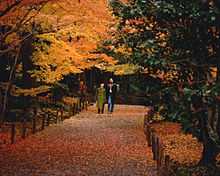Momijigari

Momijigari (紅葉狩), from the Japanese momiji (紅葉), "red leaves" or "maple tree" and kari (狩り), "hunting", is the Japanese tradition of going to visit scenic areas where leaves have turned red in the autumn. Kōyō (紅葉).[1][2] "Kōyō" is another pronunciation of the characters for "momiji" which means "fall colors" or "leaves changing colors."[3] It is also called kanpūkai (観楓会) in Hokkaidō [4][5] which means "getting together to view the leaves."[6]
Many Japanese people take part in this, with the cities of Nikkō and Kyoto being particularly famous destinations. The tradition is said to have originated in the Heian era as a cultured pursuit, and is the reason why many deciduous trees can be found in the Kyoto area.
There is also a tradition of going to see areas where grasses change colour, such as on the Oze plain.
See also
References
- ↑ AnimeLab.com: "kouyou".
- ↑ Autumn leaves (koyo) in Japan at japan-guide.com.
- ↑ http://jisho.org/
- ↑ AnimeLab.com: "kanpuukai".
- ↑ Sapporo Year-Round: Attractions and Events in Four Seasons at the official Sapporo Sightseeing Guide.
- ↑ http://jisho.org/
- This article incorporates text translated from the corresponding Japanese Wikipedia article as of November 28, 2006.
External links
- "Momijigari", Japanese events calendar